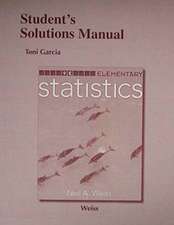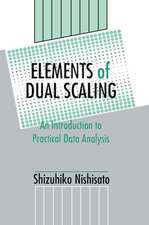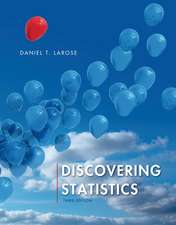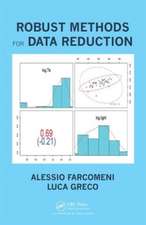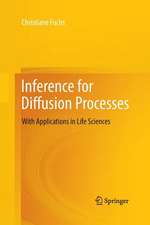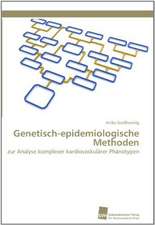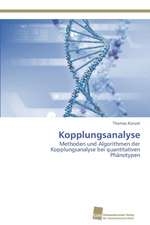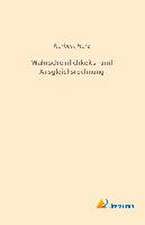Introduction to Probability
Autor Marc Mezard, Ellen Gundlach, Jackie Milleren Limba Engleză Hardback – 15 noi 2015
Preț: 491.85 lei
Preț vechi: 735.47 lei
-33% Nou
94.15€ • 102.30$ • 79.13£
Carte disponibilă
Livrare economică 01-15 aprilie
Livrare express 15-21 martie pentru 109.02 lei
Specificații
ISBN-10: 0716771098
Pagini: 704
Dimensiuni: 203 x 254 x 25 mm
Greutate: 1.32 kg
Editura: W. H. Freeman
Notă biografică
Cuprins
I Randomness
1 Outcomes, Events, and Sample Spaces
1.1 Introduction
1.2 Complements and DeMorgan's Laws
1.3 Exercises
1.3.1 Practice
1.3.2 Extensions
1.3.3 Advanced
2 Probability
2.1 Introduction
2.2 Equally-Likely Events
2.3 Complementary Probabilities; Probabilities of Subsets
2.4 Inclusion-Exclusion
2.5 More Examples of Probabilities of Events
2.6 Exercises
2.6.1 Practice
2.6.2 Extensions
2.6.3 Advanced
3 Independent Events
3.1 Introduction
3.2 Some Nice Facts About Independence
3.3 Probability of Good Occurring Before Bad
3.4 Exercises
3.4.1 Practice
3.4.2 Extensions
3.4.3 Advanced
4 Conditional Probability
4.1 Introduction
4.2 Distributive Laws
4.3 Conditional Probabilities Satisfy the Standard Probability Axioms
4.4 Exercises
4.4.1 Practice
4.4.2 Extensions
4.4.3 Advanced
5 Bayes' Theorem
5.1 Introduction to Versions of Bayes' Theorem
5.2 Multiplication with Conditional Probabilities
5.3 Exercises
5.3.1 Practice
5.3.2 Extensions
5.3.3 Advanced
6 Review of Randomness
6.1 Summary of Randomness
6.2 Exercises
II Discrete Random Variables
7 Discrete Versus Continuous Random Variables
7.1 Introduction
7.2 Examples
7.3 Exercises
7.3.1 Practice
7.3.2 Extensions
7.3.3 Advanced
8 Probability Mass Functions and CDFs
8.1 Introduction
8.2 Examples
8.3 Properties of the Mass and CDF
8.4 More Examples
8.5 Exercises
8.5.1 Practice
8.5.2 Extensions
8.5.3 Advanced
9 Independence and Conditioning
9.1 Joint Probability Mass Functions
9.2 Independent Random Variables
9.3 Three or More Random Variables That Are Independent
9.4 Conditional Probability Mass Functions
9.5 Exercises
9.5.1 Practice
9.5.2 Extensions
9.5.3 Advanced
10 Expected Values of Discrete Random Variables
10.1 Introduction
10.2 Examples
10.3 Exercises
10.3.1 Practice
10.3.2 Extensions
11 Expected Values of Sums of Random Variables
11.1 Introduction
11.2 Examples
11.3 Exercises
11.3.1 Practice
11.3.2 Extensions
12 Variance of Discrete Random Variables
12.1 Introduction.
12.2 Variance
12.3 Five Friendly Facts with Independence
12.4 Exercises
12.4.1 Practice
12.4.2 Extensions
12.4.3 Advanced
13 Review of Discrete Random Variables
13.1 Summary of Discrete Random Variables
13.2 Exercises
III Named Discrete Random Variables
14 Bernoulli Random Variables
14.1 Introduction
14.2 Examples
14.3 Exercises
14.3.1 Practice
14.3.2 Extensions
14.3.3 Advanced
15 Binomial Random Variables
15.1 Introduction
15.2 Examples
15.3 Exercises
15.3.1 Practice
15.3.2 Extensions
15.3.3 Advanced
16 Geometric Random Variables
6.1 Introduction
16.2 Special Features of the Geometric Distribution
16.3 The Number of Failures
16.4 Geometric Memoryless Property
16.5 Random Variables That Are Not Geometric
16.6 Exercises
16.6.1 Practice
16.6.2 Extensions
16.6.3 Advanced
17 Negative Binomial Random Variables
17.1 Introduction
17.2 Examples
17.3 Exercises
17.3.1 Practice
17.3.2 Extensions
18 Poisson Random Variables
18.1 Introduction
18.2 Sums of Independent Poisson Random Variables
18.3 Using the Poisson as an Approximation to the Binomial
18.4 Exercises
18.4.1 Practice
18.4.2 Extensions
18.4.3 Advanced
19 Hypergeometric Random Variables
19.1 Introduction
19.2 Examples
19.3 Using the Binomial as an Approximation to the Hypergeometric
19.4 Exercises
19.4.1 Practice
19.4.2 Extensions
20 Discrete Uniform Random Variables
20.1 Introduction
20.2 Examples
20.3 Exercises
20.3.1 Practice
20.3.2 Extensions
20.3.3 Advanced
21 Review of Named Discrete Random Variables
21.1 Summing up: How do you tell all these random variables apart?
21.2 Exercises
21.3 Review Problems
IV Counting
22 Introduction to Counting
22.1 Introduction
22.2 Sampling With Versus Without Replacement; With Versus Without Regard to Order
22.3 Counting: Seating Arrangements
22.4 Exercises
22.4.1 Practice
22.4.2 Extensions
22.4.3 Seating Arrangement Problems
23 Two Case Studies in Counting
23.1 Poker Hands
23.1.1 Straight Flush
23.1.2 Four Of A Kind
23.1.3 Full House
23.1.4 Flush
23.1.5 Straight
23.1.6 Three Of A Kind
23.1.7 Two Pair
23.1.8 One Pair
23.2 Yahtzee
23.2.1 Upper Section
23.2.2 Three Of A Kind
23.2.3 Four Of A Kind
23.2.4 Full House
23.2.5 Small Straight
23.2.6 Large Straight
23.2.7 Yahtzee
V Continuous Random Variables
24 Continuous Random Variables and PDFs
24.1 Introduction
24.2 Examples
24.3 Exercises
24.3.1 Practice
24.3.2 Extensions
24.3.3 Advanced
25 Joint Densities
25.1 Introduction
25.2 Examples
25.3 Exercises
25.3.1 Practice
25.3.2 Extensions
25.3.3 Advanced
26 Independent Continuous Random Variables
26.1 Introduction
26.2 Examples
26.3 Exercises
26.3.1 Practice
26.3.2 Extensions
26.3.3 Advanced
27 Conditional Distributions
27.1 Introduction
27.2 Examples
27.3 Exercises
27.3.1 Practice
27.3.2 Extensions
28 Expected Values of Continuous Random Variables
28.1 Introduction
28.2 Some Generalizations about Expected Values
28.3 Some Applied Problems with Expected Values
28.4 Exercises
28.4.1 Practice
28.4.2 Extensions
28.4.3 Advanced
29 Variance of Continuous Random Variables
29.1 Variance of a Continuous Random Variable
29.2 Expected Values of Functions of One Continuous Random Variable
29.3 Expected Values of Functions of Two Continuous Random Variables
29.4 More Friendly Facts about Continuous Random Variables
29.5 Exercises
29.5.1 Practice
29.5.2 Extensions
29.5.3 Advanced
30 Review of Continuous Random Variables
30.1 Summary of Continuous Random Variables
30.2 Exercises
VI Named Continuous Random Variables
31 Continuous Uniform Random Variables
31.1 Introduction
31.2 Examples
31.3 Linear Scaling of a Uniform Random Variable
31.4 Exercises
31.4.1 Practice
31.4.2 Extensions
31.4.3 Advanced
32 Exponential Random Variables
32.1 Introduction
32.2 Average and Variance
32.3 Properties of Exponential Random Variables
32.3.1 Complement of the CDF
32.3.2 Memoryless Property of Exponential Random Variables
32.3.3 Minimum of Independent Exponential Random Variables
32.3.4 Poisson Process
32.3.5 Moments of an Exponential Random Variable (Optional)
32.4 Exercises .
32.4.1 Practice
32.4.2 Extensions
32.4.3 Advanced
33 Gamma Random Variables
33.1 Introduction
33.2 Examples
33.3 Exercises
33.3.1 Practice
33.3.2 Extensions
33.3.3 Advanced
34 Beta Random Variables
34.1 Introduction
34.2 Examples
34.3 Exercises
34.3.1 Practice
34.3.2 Extensions
35 Normal Random Variables
35.1 Introduction
35.2 Using the Normal Distribution: Scaling and Transforming to Standard Normal
35.3 \Backwards" Normal Problems
35.4 Summary: How to Distinguish a \Forward" Versus \Backwards" Normal Problem?
35.5 Exercises
35.5.1 Practice
35.5.2 Extensions
35.5.3 Advanced
36 Sums of Independent Normal Random Variables
36.1 The Sum of Independent Normal Random Variables is Normally Distributed
36.2 Why the Sum of Independent Normals is Normal Too (Optional)
36.3 Exercises
36.3.1 Practice
36.3.2 Extensions
36.3.3 Advanced
37 Central Limit Theorem
37.1 Introduction
37.2 Laws of Large Numbers
37.3 Central Limit Theorem
37.4 Applications of the Central Limit Theorem to Sums of Continuous Random Variables
37.5 Applications of the Central Limit Theorem to Sums of Discrete Random Variables
37.6 Normal Approximations to Binomial Random Variables
37.7 Normal Approximations to Poisson Random Variables
37.8 Exercises
37.8.1 Practice
37.8.2 Extensions
38 Review of Named Continuous Random Variables
38.1 Summing up: How do you tell all these random variables apart?
38.2 Exercises
VII Additional Topics
39 Variance of Sums; Covariance; Correlation
39.1 Introduction
39.2 Motivation for Covariance
39.3 Properties of the Covariance
39.4 Examples of Covariance
39.5 Linearity of the Covariance
39.6 Correlation
39.7 Exercises
39.7.1 Practice
39.7.2 Extensions
39.7.3 Advanced
40 Conditional Expectation
40.1 Introduction
40.2 Examples
40.3 Exercises
40.3.1 Practice
40.3.2 Extensions
40.3.3 Advanced.
41 Markov and Chebyshev Inequalities
41.1 Introduction
41.2 Markov Inequality
41.3 Chebyshev Inequality
41.4 Exercises
41.4.1 Practice
41.4.2 Extensions
42 Order Statistics
42.1 Introduction
42.2 Examples
42.3 Joint Density and Joint CDF of Order Statistics
42.4 Exercises
42.4.1 Practice
42.4.2 Extensions
43 Moment Generating Functions
43.1 A Brief Introduction to Generating Functions
43.2 Moment Generating Functions
43.3 Moment Generating Functions of Discrete Random Variables
43.4 Moment Generating Functions of Continuous Random Variables
43.5 Appendix: Building a Generating Function
43.6 Exercises
44 Transformations of One or Two Random Variables
44.1 Distribution of a Function of One Continuous Random Variable
44.2 Joint Density of Two Random Variables That Are Functions of Another Pair of Random Variables
44.3 Exercises
44.3.1 Practice
44.3.2 Extensions
44.3.3 Advanced
45 Review Questions for All Chapters


